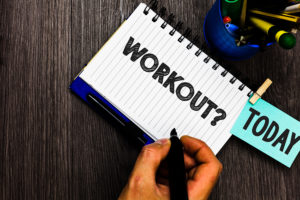 Rob and I encourage all seniors to do physical exercise every day. But what happens when the following day you are really sore and exhausted? Today, for example, I ache all over from playing Pickle Ball and from a body-building session with my trainer.
Rob and I encourage all seniors to do physical exercise every day. But what happens when the following day you are really sore and exhausted? Today, for example, I ache all over from playing Pickle Ball and from a body-building session with my trainer.
Here’s what Dr. Google reports from the Mayo Clinic:
Exercise: 7 benefits of regular physical activity – Mayo Clinic: Exercise boosts energy. … Regular physical activity can improve your muscle strength and boost your endurance. Exercise delivers oxygen and nutrients to your tissues and helps your cardiovascular system work more efficiently. And when your heart and lung health improve, you have more energy to tackle daily chores.
Yes, I know, I know. But what about my body, the aches and pains? I’m worried that at 74, a good night’s rest isn’t enough time to recover. I don’t want to be vulnerable to injuries because of over-training.
Muscle Stress Triggers Repair and Rebuilding
The amazing thing about the body is that it repairs itself. But only if you give it a chance. There’s a fine line between exercising enough to get the benefits, and stressing your body too much. Seniors often struggle with this, wasting time in the gym because they don’t push their muscles sufficiently to promote muscle growth. Others push too much and expect their older bodies to respond like 20 years ago.
I think every year my muscles take longer to recover. I’m sore for more than 24 hours. Sometimes I need 48 hours. I’ve found a solution so that I don’t have to sit around for a couple of days.
When you want to build muscle (and in doing so, use up fat reserves), you need to contract them as many times as possible, usually with weights. Some advocate repetitions to the point of exhaustion. When you do that, there are little tears in the muscles fibers, causing soreness and a build up of lactic acid. This triggers a sequence of biochemical reactions that repair the damage by building new muscle tissue.
When you over-train, you aren’t letting the body complete the repair work because you are adding additional stress before it has a chance to rebuild. Hence, you are vulnerable to injury. Those muscles need rest and recovery. Fortunately, the soreness will let us know that we need more time to heal.
How Often Should Seniors Exercise?
The older we are, the more time it takes to repair stressed muscles. But like many of my friends, I have a hard time sustaining an exercise habit without a daily routine.
Both Rob and I believe you need daily exercise for a couple of reasons. First, there are so many muscles in the body that you can easily work different body parts each day. Second, it’s easier to wake up and know you are going to go exercise. If I have to think about it (Is this a gym day? Maybe I can skip today and go tomorrow?), I might fudge and put it off.
So I’ll work upper body one day, legs the next and so forth. But here’s another way of organizing your daily fitness schedule.
Four Types of Daily Exercise
There are four kinds of exercise that are distinctly different. Each category needs to be addressed for all-around fitness, especially for seniors who want to avoid injuries.
1. Strength training: It doesn’t matter if you do weight lifting, or use machines, or your own body weight. The goal is to progressively increase the load your muscles can handle. You can vary body areas and repetitions (lighter weight, more repetitions vs. heavier weights and fewer repetitions). You can contract muscles by lifting or pulling, as well as extending them with lunges and presses.
2. Cardiovascular training: This type focuses on the heart, breathing, and speed. You can engage in running, walking, rowing, bicycling, spinning, jumping or any activity that gets your heart beating faster. Seniors lose a lot of lung efficiency each year. This can be measured with a VO2 device. Try High Intensity Interval Training (HIIT) to improve your lungs.
3. Stretching and Flexibility: Without training your muscles to stretch, they will contract over time and you will have difficulties with posture.This is why so many seniors appear hunched over. But the worst consequences of not stretching is that it becomes easier to sprain an ankle or wrist, and tendons and joints become stiff and painful. Yoga, Pilates, and Tai Chi are excellent ways to preserve flexibility.
4. Balance: I know very few seniors who make an effort to stand on one foot to improve balance. But loss of balance is a major cause of falling. The statistics on senior falls are horrible. Falls lead to fractures, loss of mobility and independence, and sometimes death. Balance is such a simple thing we take for granted. Try this: every morning as you have your coffee or tea, stand facing a mirror and lift one knee up. Hold for at least 30 seconds. Try it again with your eyes closed! Trouble at first? Stand next to a wall so you can reach out and touch it to reset your balance.
There you have it, four ways to vary your daily exercise routine. Variety prevents boredom and over-training. Personally, I am a big fan of using a personal trainer. Fortunately where we live, Mexico, there are excellent trainers who don’t charge an arm or a leg. Or should I say a bicep or a quadricep?

Recent Comments